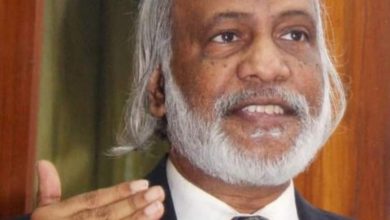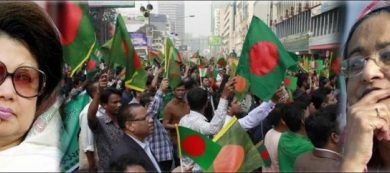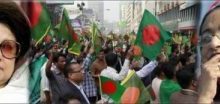The Unveiling of a New Era in Bangladesh Under Tarique Rahman’s Leadership

By Asif Armani
Bangladesh has witnessed a seismic shift in its political landscape recently, with the ousting of autocrat Sheikh Hasina’s government in the July uprising and the glorious August 5 revolution, marking the dawn of what could be a new democratic era. At the forefront of this political revolution stands Tarique Rahman, the action chairperson and undisputable leader of the Bangladesh Nationalist Party (BNP), who managed to bring his party to the heart of this movement through a bold strategy and masterful leadership.




Despite countless obstacles, Tarique Rahman held the BNP together, keeping the flame of opposition alive through turbulent years marked by authoritarian clampdowns and political suppression. It was his unique approach this time, however, that transformed a typical anti-government sentiment into a countrywide movement for change, leading to the glorious August 05 revolution.Tarique’s strategy this time around was unorthodox yet highly effective. Moving away from conventional oppositional tactics, he leveraged the raw power of student activism to create a groundswell of resistance against Hasina’s administration.
By mobilizing students across the country and integrating his loyal cadre within their ranks without overt party affiliations, Rahman gave the movement the semblance of a spontaneous uprising. This fresh approach was instrumental in generating widespread support across Bangladesh, fostering a unified front that resonated with people from all walks of life.
The Student Movement of July 2024:
A Catalyst for ChangeStudent activism has always played a pivotal role in shaping Bangladesh’s history, and Tarique tapped into this rich legacy to catalyse change. His understanding of the youth’s growing discontent with the Hasina government’s authoritarian grip and systemic corruption allowed him to create an environment ripe for revolt.

Tarique tasked several of his key allies with the responsibility of mobilizing students in universities and colleges, especially targeting major urban centres where disillusionment with the government was palpable. However, he was careful to avoid an overt BNP label on the movement. Instead, he instructed his party’s youth wing, the Jatiyatabadi Chhatra Dal (JCD), to blend in as regular students, making the movement appear as a people-driven revolt rather than a political manoeuvre.
The strategy paid off, as students took to the streets in unprecedented numbers, their slogans calling for freedom, justice, and an end to government corruption echoing across the nation. The government’s attempts to dismiss the movement as a politically orchestrated stunt only fuelled its momentum. Ordinary citizens began to rally behind the students, and the movement quickly transcended its initial demographic, growing into a nationwide force. Tarique’s decision to keep his party’s affiliation in the background meant that people saw the movement as a united effort to reclaim their rights rather than a BNP power play. A Movement Marked by SacrificeThe path to this revolutionary outcome was anything but easy. Over 422 BNP activists laid down their lives in a violent crackdown by government forces determined to crush the uprising. Tarique’s determination to avoid a direct confrontation between his party and the government only served to highlight the sacrifices of these activists, who risked and ultimately gave their lives to stand up for Bangladesh’s future. Altogether more than 2000 lives were sacrificed to achieve this august freedom. This sacrifice not only galvanized public support but also served as a stark reminder of the Hasina administration’s oppressive tactics.In many ways, the deaths of these activists became a rallying cry for the movement, with their stories of courage and resilience resonating deeply within the hearts of ordinary citizens. The government’s harsh response inadvertently backfired, as reports and images of violence against unarmed students and activists spread through social media, fuelling widespread outrage. The movement thus became not just a call for political change but a moral crusade against a regime perceived as fundamentally unjust and oppressive. Tarique’s choice to have his activists blend with students ensured that their sacrifices felt personal to every Bangladeshi, making the movement impossible to ignore.

Tarique’s Strategic Brilliance:
A Break from TraditionTarique’s approach to leadership in this movement marked a significant departure from traditional opposition strategies in Bangladesh. Instead of positioning BNP at the front of the protests, he allowed the movement to grow organically through the collective voice of the youth. This strategic choice not only protected the BNP from immediate crackdowns but also empowered the students to take ownership of the movement, transforming it into a genuine people’s uprising.
Moreover, Tarique’s low-key presence meant that he avoided being seen as merely an oppositional figure but instead as a leader willing to put the people’s will above his own political ambitions. This authenticity resonated deeply with Bangladesh’s citizens, who have grown weary of self-serving politics. His leadership style, emphasizing decentralization and grassroots mobilization, has set a new precedent in Bangladeshi politics, demonstrating that true change can come from the people when given the opportunity to express their voices.Tarique’s decision to maintain a strategic distance from the limelight during the uprising also allowed him to direct the movement without becoming a target.
By positioning students as the face of the movement, Tarique drew from Bangladesh’s own history of youth-led protests, echoing the nation’s founding liberation struggle, when his father Zia, a young army Major in his mid-thirties, declared the independence of Bangladesh. This nod to the country’s past made the movement feel authentically Bangladeshi, garnering respect even from those traditionally opposed to the BNP. His ability to unite people under a common cause beyond party politics has been one of his most remarkable achievements, one that other opposition leaders in the region may look to emulate.
The Role of Digital Activism
The success of the movement was also bolstered by the efforts of digital activists who spread the message of resistance across social media platforms. Figures like Dr Mahmudur Rahman, Dr Pinaki Bhattacharya, Dr Taz Hashmi, Solicitor Shamsul Alam Liton, Dr. Kanak Sarwar, Elias Hossain, Hasina Akter and Zulkarnain Saer Sami, to name a few, played an instrumental role in galvanizing support online. Through videos, blogs, and social media posts, these activists highlighted government corruption, censorship, and human rights abuses, inspiring the youth to demand change.
Dr Pinaki Bhattacharya, in particular, became a household name, with his sharp critiques of Indian hegemony and the Hasina regime striking a chord with a populace increasingly wary of foreign influence.The efforts of these online activists cannot be understated, as they provided the movement with a platform that reached beyond the borders of Bangladesh, drawing international attention to the protests. While the mainstream media in Bangladesh was heavily censored, social media became an alternative channel for truth, allowing activists to bypass government restrictions and directly engage with the people.
Tarique’s collaboration with these activists demonstrated his ability to adapt to modern forms of political engagement, a necessity in an era where information moves at lightning speed. Implications for India-Bangladesh RelationsOne of the most significant aspects of this uprising is its implications for Bangladesh’s relationship with India. The BNP’s stance against Indian hegemony has garnered widespread support within Bangladesh, where resentment towards India’s influence in the Hasina administration has been growing. Tarique’s movement tapped into this discontent, positioning itself not only as a struggle for democracy but also as a statement of national sovereignty, following the footprints of his legendary father Shaheed president Ziaur Rahman who led Bangladesh in the late 70s and early 80s.India, long seen as a key ally of the Hasina government, now faces the challenge of recalibrating its approach to Bangladesh under Tarique’s leadership. With Tarique’s ascension, India’s role in Bangladesh’s internal politics is likely to face increased scrutiny.
Tarique’s focus on strengthening Bangladesh’s sovereignty and reducing external influence aligns with his commitment to a self-reliant Bangladesh. This shift could lead to a re-evaluation of Indo-Bangladeshi relations, as Rahman seeks to foster more balanced and mutually respectful diplomatic ties.
A Vision for the Future of Bangladesh
Tarique’s rise to prominence marks a transformative moment in Bangladesh’s political history. His commitment to restoring democratic principles, ensuring justice, and protecting Bangladesh’s sovereignty has struck a chord with the country’s citizens. Under his leadership, there is a renewed hope for a political system that serves the people, prioritizes their rights, and upholds the rule of law.However, with his newfound influence comes the challenge of turning this revolutionary fervour into lasting change. The road ahead will require careful navigation, as Rahman must now transition from a movement leader to a statesman capable of leading a diverse, dynamic nation. His ability to sustain the momentum of this revolution and translate it into concrete policies will be crucial for Bangladesh’s future.
The Challenges AheadWhile Tarique’s movement has achieved significant success, the challenges ahead are formidable. Establishing democratic institutions in a country where authoritarianism has taken deep roots will be no easy feat. The process of reforming Bangladesh’s political, legal, and bureaucratic systems will require both patience and resilience. Rahman will need to build coalitions, foster dialogue, and find common ground with various stakeholders to ensure a stable transition of power.Furthermore, when elected, he must address the social and economic disparities that fuelled the discontent against the previous regime. Economic inequality, unemployment, and corruption remain pressing issues that demand urgent attention. Tarique’s commitment to these issues will be tested as he seeks to balance the expectations of a hopeful populace with the realities of governing a nation in transition. A New Chapter in Bangladesh’s HistoryThe recent uprising, under Tarique Tarique’s leadership, represents a new chapter in Bangladesh’s history—one marked by the power of the people to bring about change. Tarique’s ability to unite citizens across the country, his strategic use of student activism, and his skillful navigation of political challenges have set him apart as a visionary leader. In a country that has long grappled with the legacy of authoritarianism, Tarique’s emphasis on democracy, justice, and national sovereignty offers a fresh perspective on what Bangladesh could achieve.For Bangladesh, this moment is filled with promise.
The people have spoken, and their message is clear: they desire a Bangladesh where democracy thrives, where leaders are accountable, and where every citizen’s voice matters. Tarique’s leadership has made this dream seem within reach. At the moment the country is being run by Nobel laureate Dr Yunus, but everybody knows Tarique is the prime-minister in waiting. His unprecedented popularity among the youths of Bangladesh, the catalyst of recent changes, is only comparable with that of his father late President Zia and his equally illustrious mother former prime minister Begum Khaleda Zia. As Bangladesh moves forward, the world will be watching to see how this new era unfolds and whether Tarique can fulfil the hopes of a nation yearning for freedom and change.
Asif Armani: writer is a thinker and diplomatic analyst.








